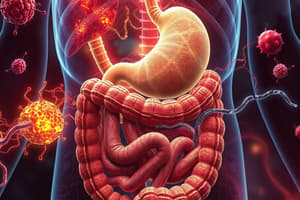Podcast
Questions and Answers
What happens to water molecules in the plant when some molecules leave through open stomata?
What happens to water molecules in the plant when some molecules leave through open stomata?
- They are pulled up through the xylem (correct)
- They move randomly through the plant
- They are attracted to the stomata
- They are pushed down through the xylem
What is the effect of increased temperature on the rate of transpiration?
What is the effect of increased temperature on the rate of transpiration?
- It decreases the rate of transpiration
- It increases the rate of photosynthesis only
- It increases the rate of transpiration and photosynthesis (correct)
- It has no effect on the rate of transpiration
What is the effect of high relative humidity on the rate of transpiration?
What is the effect of high relative humidity on the rate of transpiration?
- It increases the rate of photosynthesis
- It has no effect on the rate of transpiration
- It increases the rate of transpiration
- It decreases the rate of transpiration (correct)
What is the result of increased air movement around the leaf?
What is the result of increased air movement around the leaf?
What is the role of stomata in the process of transpiration?
What is the role of stomata in the process of transpiration?
What is the term for the concentration of water vapour in the air?
What is the term for the concentration of water vapour in the air?
Why does the rate of transpiration increase when the temperature increases?
Why does the rate of transpiration increase when the temperature increases?
What is the effect of increased air movement on the concentration of water vapour around the leaf?
What is the effect of increased air movement on the concentration of water vapour around the leaf?
What is the relationship between the rate of transpiration and the rate of evaporation?
What is the relationship between the rate of transpiration and the rate of evaporation?
Why does the rate of transpiration decrease when the relative humidity is high?
Why does the rate of transpiration decrease when the relative humidity is high?
Flashcards are hidden until you start studying
Study Notes
Principles of Organisation
- Cells are the basic units of life, and a group of specialized cells with similar structure and function form a tissue.
- Organs are formed by a number of different tissues working together to produce a specific function.
- Organs are organized into organ systems, which work together to perform a certain function.
The Human Digestive System
- The digestive system is an organ system that breaks down food into smaller molecules that can be absorbed by cells.
- It consists of glands (salivary glands and pancreas) that produce digestive juices containing enzymes, stomach, small intestine, liver, gall bladder, and large intestine.
- Enzymes are biological catalysts that increase the rate of reaction without being used up, and are present in many reactions to control them.
- Enzymes are protein molecules that have a unique shape, with an active site where the substrate binds, allowing the enzyme to break down large molecules or join small ones.
Enzymes
- Enzymes require an optimum pH and temperature (around 37°C) to function, and are denatured above this temperature.
- The Lock and Key Hypothesis explains how enzymes work, where the substrate binds to the active site, forming an enzyme-substrate complex, and the reaction takes place.
Respiration
- Oxygen diffuses down its concentration gradient into the capillary bloodstream, which has a low concentration of oxygen.
- Carbon dioxide diffuses down its concentration gradient from the blood to the alveoli.
- Alveoli are adapted for gas exchange, with a large surface area, short diffusion pathway, and a large blood supply.
Blood
- Blood is made up of plasma, red blood cells, white blood cells, and platelets.
- Plasma carries the components in the blood, including glucose, amino acids, carbon dioxide, urea, hormones, proteins, antibodies, and antitoxins.
- Red blood cells carry oxygen molecules from the lungs to all the cells in the body, and have a bioconcave disc shape that provides a large surface area.
Plant Organisation
- Xylem is found in roots, stems, and leaves, and allows the movement of water and mineral ions from the roots to the stem and leaves.
- Phloem is also found in roots, stems, and leaves, and allows the movement of food substances in both directions.
- Transpiration stream is the continuous movement of water from the roots to the stem and leaves, where it evaporates.
Transpiration
- The rate of transpiration is affected by factors such as temperature, relative humidity, and air movement.
- An increase in temperature increases the rate of transpiration, as do an increase in light intensity and air movement, while an increase in relative humidity decreases the rate of transpiration.
Studying That Suits You
Use AI to generate personalized quizzes and flashcards to suit your learning preferences.




